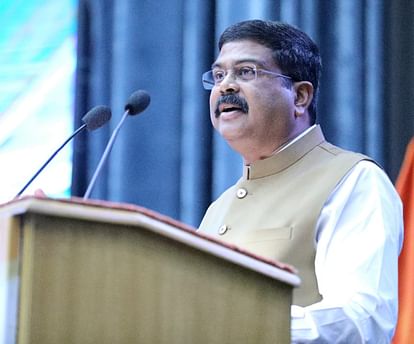
Education Minister Dharmendra Pradhan
- PC : Social Media
Survey: At least 78 percent of parents in rural India aspire to educate their daughters until graduation and beyond, according to a survey report.
The 'State of Elementary Education in Rural India-2022' report, based on a survey of 6,229 rural households from across 20 states, was released by Union Education Minister Dharmendra Pradhan on Tuesday evening.
The 'State of Elementary Education in Rural India-2022' report, based on a survey of 6,229 rural households from across 20 states, was released by Union Education Minister Dharmendra Pradhan on Tuesday evening.
"Analyzing the gender distribution of the children, the findings indicate that parents exhibit a similar inclination for both their female and male children to pursue advanced education, including technical degrees, graduation, and postgraduate degrees. Parents of 82 percent of boys and 78 percent of girls want to educate their children to graduation and above," it said.
The survey revealed that out of the total number of dropped-out children, around one-fourth of male children discontinued their education during primary schooling.
"Comparatively, the dropout rate at that stage was higher for female children, reaching 35 percent. A higher proportion of both boys and girls dropped out of school after completing the primary school education (75 percent for boys and 65 percent for girls).
"Non-availability of schools with higher sections within the village or nearby villages might have been a reason why these children dropped out after completing the primary sections," it added.
The study, which focused on six-to-16-year-old children in rural communities, was conducted by the Development Intelligence Unit (DIU), an initiative of the Transforming Rural India Foundation (TRIF) and Sambodhi Pvt, with a vision to present data along with the right analytics and insights to stimulate action among stakeholders in rural India's development.
The survey found that a majority of children (62.5 percent) are under the supervision of their mothers when it comes to their studies, while 49 percent are supervised by their fathers.
"This highlights the important role parents play in guiding and supporting their children's academic pursuits at home. Additionally, over 38 percent of parents opt for private tutors to further enhance their children's education. It is often seen that in rural India, supervision is often carried out by people other than the parents of children."
For instance, 25.6 percent of the children study under the guidance of an elder sibling, 3.8 percent are supervised by anganwadi workers, and 7.6 percent are taught by community teachers.
"Comparatively, 64 percent of these children receive supervision from their mothers, while 50 percent are supervised by their fathers. About 26 percent of the children study under the supervision of a private tutor," the report added.
The survey also investigated the time spent on smartphones by children.
"Overall, nearly 73 percent of children utilize smartphones for less than two hours daily. Notably, older children tend to spend more time on their phones, with 25.4 percent of children in class 8 and above dedicating two to four hours, in contrast to 16.8 percent of children in classes 1 to 3," it added.
The survey revealed that out of the total number of dropped-out children, around one-fourth of male children discontinued their education during primary schooling.
"Comparatively, the dropout rate at that stage was higher for female children, reaching 35 percent. A higher proportion of both boys and girls dropped out of school after completing the primary school education (75 percent for boys and 65 percent for girls).
"Non-availability of schools with higher sections within the village or nearby villages might have been a reason why these children dropped out after completing the primary sections," it added.
The study, which focused on six-to-16-year-old children in rural communities, was conducted by the Development Intelligence Unit (DIU), an initiative of the Transforming Rural India Foundation (TRIF) and Sambodhi Pvt, with a vision to present data along with the right analytics and insights to stimulate action among stakeholders in rural India's development.
The survey found that a majority of children (62.5 percent) are under the supervision of their mothers when it comes to their studies, while 49 percent are supervised by their fathers.
"This highlights the important role parents play in guiding and supporting their children's academic pursuits at home. Additionally, over 38 percent of parents opt for private tutors to further enhance their children's education. It is often seen that in rural India, supervision is often carried out by people other than the parents of children."
For instance, 25.6 percent of the children study under the guidance of an elder sibling, 3.8 percent are supervised by anganwadi workers, and 7.6 percent are taught by community teachers.
"Comparatively, 64 percent of these children receive supervision from their mothers, while 50 percent are supervised by their fathers. About 26 percent of the children study under the supervision of a private tutor," the report added.
The survey also investigated the time spent on smartphones by children.
"Overall, nearly 73 percent of children utilize smartphones for less than two hours daily. Notably, older children tend to spend more time on their phones, with 25.4 percent of children in class 8 and above dedicating two to four hours, in contrast to 16.8 percent of children in classes 1 to 3," it added.






